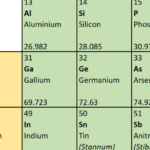The Secret Lives of the Elements
The Secret Lives of the Elements by Dr. Kathryn Harkup was released in the UK in October 2021. The reviewed copy from Mobius Books is from the US release in March 2022.
Reviewed by Steven Spence @TheStevenSpence

I immediately noticed the distinctive cover by Luke Bird (design) and Jo Parry (illustrations). The paneled design with bold colors, retro 1950s/1960s style illustrations, and clean blocks separating the visual components is consistently used throughout the book. It provides a familiar visual point of reference for each chapter, allowing readers to gather information quickly. Examples are teal for Group 1 and 2 metals, orange for non-metals, red for transition metals, and green for the Lanthanide and Actinide series. Information on physical aspects of each element, such as the melting and boiling points, electron orbitals, and a representation of the ideal crystal structure are included. The other panels are related to aspects described in the text.
A book about chemical elements sounds like a dry affair, but far from it. Dr. Harkup excels at making the periodic table come alive with three-page chapters on each of the fifty-two elements she introduces to the reader. Each element is nicknamed to help illustrate its “personality.” Engaging stories make each element memorable and frequently lead the reader to ask additional questions. A few examples to whet the reader’s appetite:
- Sir Humphrey Davy, a showman in the scientific community, announced a new element for the 1807 Bakerian Lecture at the Royal Society before he had found it.
- A color-blind spy triggered the development of special rocket fuels.
- Van Gogh’s choice of chromium-based pigments in his famous painting, Sunflowers.
- Why you want to avoid chemists working with selenium.
The list could easily be extended without divulging too much of the book’s contents. There are fifty-two genuinely engaging vignettes providing an enjoyable introduction to each element. Therein lies Dr. Harkup’s brilliance as a scientific communicator. She simplified each element’s idiosyncrasies and technical aspects with an easily accessible story, making them memorable. There are no intimidating formulas, jargon-laden passages, or anything else to distract the reader. Dr. Harkup’s style is refreshingly direct, treating the reader as an equal on tour through the periodic table.
The Secret Lives of the Elements is available for purchase in hardcover and Kindle formats The book is highly recommended for curious minds in high school or beyond.
About Dr. Harkup
Science communicator, chemist & vampirologist. Kathryn is a chemist and author. She completed a doctorate on her favorite chemicals, phosphines, and went on to further postdoctoral research before realizing that talking, writing and demonstrating science appealed a bit more than hours slaving over a hot fume-hood. She writes and gives regular public talks on the disgusting and dangerous side of science.
Kathryn’s first book was the international best-seller A is for Arsenic: The Poisons of Agatha Christie, which was shortlisted for a Mystery Readers International Macavity Award and a BMA Book Award. She has also written Making the Monster: The Science of Mary Shelley’s Frankenstein, Death by Shakespeare: Snakebites, Stabbings and Broken Hearts and Vampirology: The Science of Horror’s Most Famous Fiend. Her most recent book is The Secret Lives of the Elements.
About Steven Spence
Avid reader of Calvin and Hobbes. Steven enjoys nature photography, dinosaurs, and all things related to astronomy. Ironically, for someone reviewing Dr. Harkup’s book on the periodic table elements, he had to be “that guy.” Yes, he went down a nuclear rabbit hole and put Helium in the “wrong” place.
Steven occasionally writes about scientific topics and books. He lives in Germany, working as an IT Manager by day. In his free time Steven reflects on the universe with his feline companions, Silver and Stardust. The three share a deep distrust of free neutrons and fascination with avian dinosaurs. Steven also writes the blog There Be Dragons Everywhere.
Science Connected Book Reviews are independently written and published without compensation of any kind from the publisher or author. If you purchase a book through an included link, our organization may receive a small commission from the vendor. Commissions help to fund our nonprofit programs.




